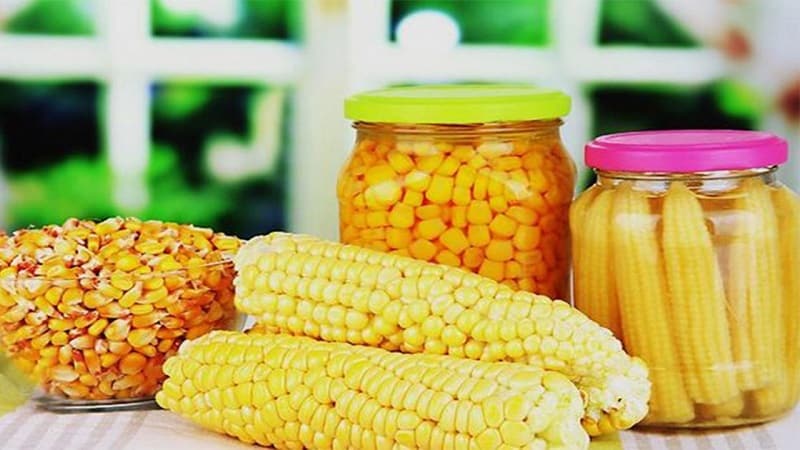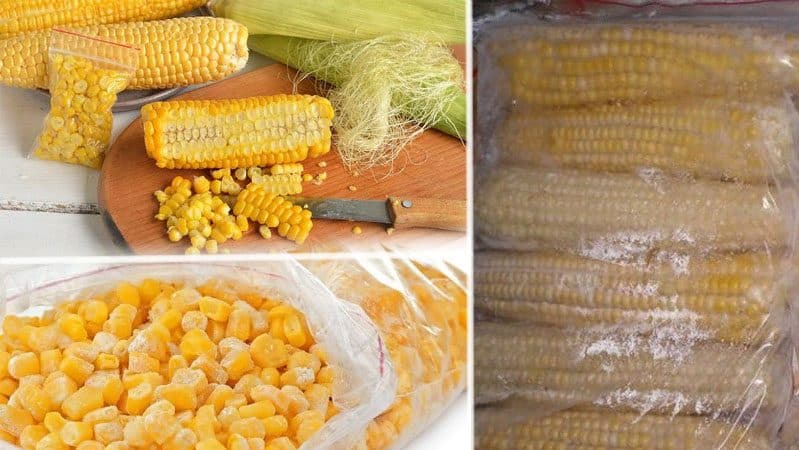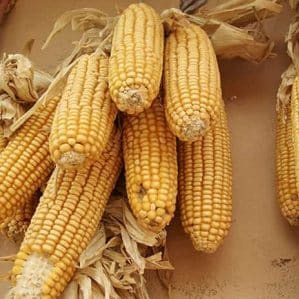Where and how to store corn on the cob at home: optimal conditions and shelf life
Corn is an amazing plant, domesticated in North America several thousand years ago. Today, corn is not only consumed as food in almost every country, but also alcohol, paste, plastic, plaster, industrial filters and animal feed are made from this plant. Not only grains are used, but also leaves, stems and cob wrappers.
Ripe corn kernels rich in vitamins and microelements. It's good to eat them all year round, but keeping the harvested cobs fresh is not so easy. Picked fruits quickly lose their taste and spoil. Today we will tell you how to store corn on the cob at home correctly in order to maximize the shelf life of the product.
Which corn is suitable for long-term storage?
Harvesting corn on the cob for the winter is the best option for storing this vegetable.. This approach allows you to keep the grains sweet and tasty. However, it is worth considering that storing cobs requires much more space, especially with an impressive harvest.
 Late varieties of corn are stored for long-term storage. The skin of the grains of such fruits is hard and allows you to preserve the properties of the product.
Late varieties of corn are stored for long-term storage. The skin of the grains of such fruits is hard and allows you to preserve the properties of the product.
This is interesting! On an industrial scale, corn is stored on the cob. Even if you send them for processing in the winter or spring of next year, they will retain all their qualities. This is how oil, molasses, starch, and flour are obtained from grains.
If you cook this corn after several months of storage, it will be almost the same as after harvest, but harsh and less sweet.
Features of storage of food and feed corn
There are food and fodder varieties of the crop. Food grades have short, round, light beige fruits. The grains of such corn are sweeter and tastier, and their consistency is softer and juicier.
Feed corn is distinguished by large, long cobs with bright yellow or orange kernels. These varieties are closer to their wild ancestors. The grains of such corn are harder and fleshier, with a tough shell.
Under industrial conditions, harvested cobs of edible corn are stored refrigerated for no more than 20 days (at a temperature of about 0°C). When the temperature rises to +10°C, the grains lose more than 1.5% of sugars per day, and at a temperature of +25°C...+30°C – up to half of the sugars per day. After just two days, such a product becomes unfit for consumption.
Forage varieties have better keeping quality. Cobs that are well prepared for storage, sorted, disinfected and cooled, are stored in special warehouses for several months.
How to Store Fresh Corn on the Cob
Storing fresh corn on the cob keeps the kernels juicier and tastier than storing the kernels in bulk. Depending on the chosen processing method, the shelf life of the product ranges from several days to one and a half years. Freshly picked raw fruits are stored at home in several ways.
Preparing the vegetable
Before storing the product, it is prepared.
Important! Corn intended to be stored on the cob is not washed.
First, corn cobs are thoroughly cleaned of leaves and fibers.Damaged specimens are rejected. Then the fruits are laid out in plastic bags and put into the refrigerator in the department for vegetables and fruits.

Storage space
Fresh cobs are stored in a cool, dark place.. This could be a refrigerator, cellar or basement.
Corn intended for making popcorn should not be stored in the refrigerator. There the grains swell and the skin becomes soft. This negatively affects the popcorn making process.
Terms and conditions of storage
The shelf life of fresh corn at home depends on the quality of the original product.
On average, cobs are stored in the refrigerator for no more than 5-7 days. Moreover, during the first three days the grains will be as sweet as freshly harvested. With longer storage, the taste of the product deteriorates.
Other options for storing corn on the cob for the winter
In addition to being stored fresh, corn cobs are canned, dried and processed. freezing. Let's consider each of these methods in detail.
Canning
Canning corn on the cob for the winter is an unusual and tasty way to store the golden fruit. For preservation, small cobs 10-15 cm long are used. They can be eaten together with the base. Young cobs are chosen for preparations sugar varieties with well-formed grains.
Here are some simple recipes.

Salted corn
This recipe is remarkable because it requires only salt, water and young corn cobs. For 1 liter of water use 1 tbsp. l. salt with a slide.
Cooking process:
- The cobs are cooked until tender and cooled.
- Bring the water to a boil, add salt and cool.
- Corn is placed vertically in prepared jars and filled with brine.
- The jars are sterilized in boiling water for 1-2 hours (depending on the size of the cobs and jars).
- The blanks are rolled up and cooled.
Pickled corn
Fans of spicier snacks will surely enjoy it recipe using vinegar and spices. For a liter jar of the preparation, take five or six small cobs, 1 tbsp. l. salt and sugar, 3 tbsp. l. vinegar. Instead of vinegar, you can use citric acid.
Cooking process:
- Cleaned cobs are placed in jars.
- Add salt, sugar and vinegar to each jar.
- Pour cold water over the corn.
- The jars are sterilized in boiling water.
- The blanks are rolled up and cooled.
Drying
Another way to preserve tasty and healthy fruits for the winter. The specimens intended for drying are sorted out. Remove spoiled, wrinkled, or with signs of rotting. All leaves are not removed with this storage method; you just need to slightly open the grains.
The prepared heads of cabbage are hung in a dry, dark room. The cobs are placed one at a time, in pairs or weaving several pieces into braids.
Dried corn is cooked in the same way as fresh corn.
Freezing

Fresh corn on the cob is easy to freeze. To do this, the fruits are cleared of leaves and fibers and sorted. The ends with unripe grains are cut off to save space in the freezer.
Selected cobs are prepared before freezing. First, they are immersed in boiling water for two minutes, and then cooled for 1-2 minutes in ice water. After this, dry it on a towel.
When the cobs are dry, they are placed in plastic bags or wrapped in cling film and put in the freezer. This way corn can be stored for up to one and a half years without loss of quality.
Storing corn on the cob at home (not for a long time)
Unfortunately, tasty and healthy corn does not have good shelf life. How long does a fresh ear of corn last? At room temperature it remains fresh for no longer than 10 hours. Storage in the refrigerator extends the period up to 5 days.
Important! It is impossible to preserve corn until the next harvest without freezing and canning.
When stored in the refrigerator, the cobs retain a delicate sweet flavor for the first three days. The process of breaking down the sugars then makes the grains less sweet.
Corn intended for making popcorn should not be stored in the refrigerator. The skin of the grains softens from excess moisture, and the yield of the finished product is significantly reduced.
Before and after cooking
Freshly picked fresh cobs are cleaned of leaves and fibers. Damaged and rotten grains are removed. Unwashed, peeled corn cobs are packaged in plastic bags or containers and placed on the bottom shelf of the refrigerator.

You can also store boiled fruits. At room temperature they are stored for 10-12 hours.
Store boiled corn in the refrigerator wrapped in cling film. Or they put a pot of corn in the refrigerator, leaving the cobs in the water in which they were boiled. Boiled corn on the cob stays fresh for 2-3 days.
In addition, boiled corn is frozen. To do this, remove the cobs from the pan, cool and dry. Then each is wrapped in cling film and placed in the freezer.
When deep frozen in the freezer, the product will last for several months. Before using, place the cobs in a saucepan and cook for 10 minutes.
Tips and tricks
There are two main reasons for the reduced shelf life of ripe cobs:
- violation of product procurement technology (insufficient cleaning before storage, use of dirty containers, etc.);
- failure to comply with recommended temperature and humidity levels (humidity above 15% and temperature above 4°C).
Thus, compliance with the following recommendations will increase the shelf life of fresh and cooked products:
- Clean the cobs thoroughly before storing.
- Store corn in an airtight container - the lack of air access inhibits the rotting process.
- When canning, use clean, sterilized containers.
- If you decide to freeze a large batch of corn, be sure to label the freeze date. Next season, last year’s preparations will be easy to distinguish and use first.
- Canned corn quickly deteriorates after the jar is depressurized, so once you open it, use its contents immediately.
Conclusion
You can preserve corn on the cob for a long time only by canning and freezing. In the refrigerator, raw and cooked heads of cabbage remain fresh for several days. And at room temperature the product is stored for no more than 12 hours.